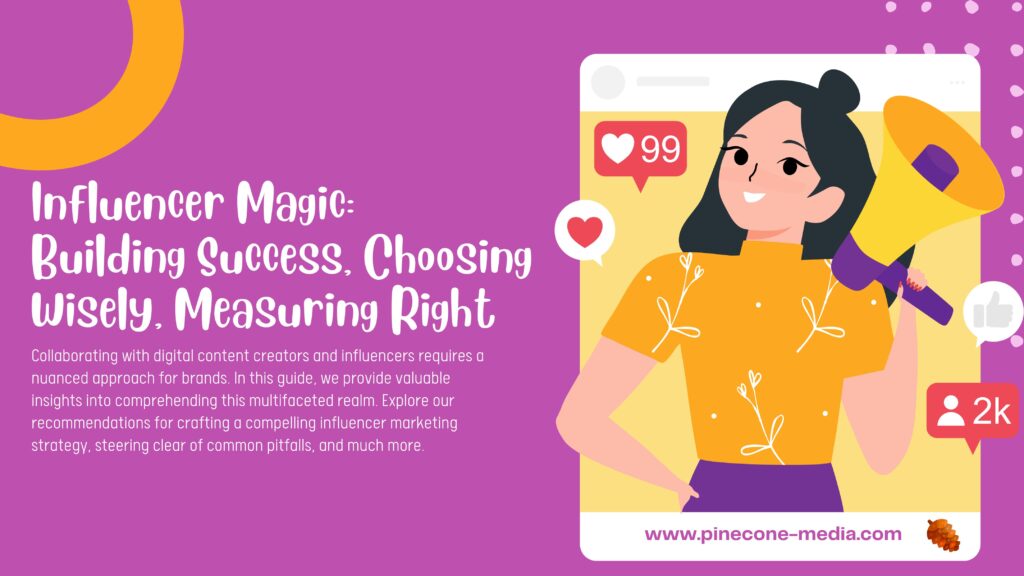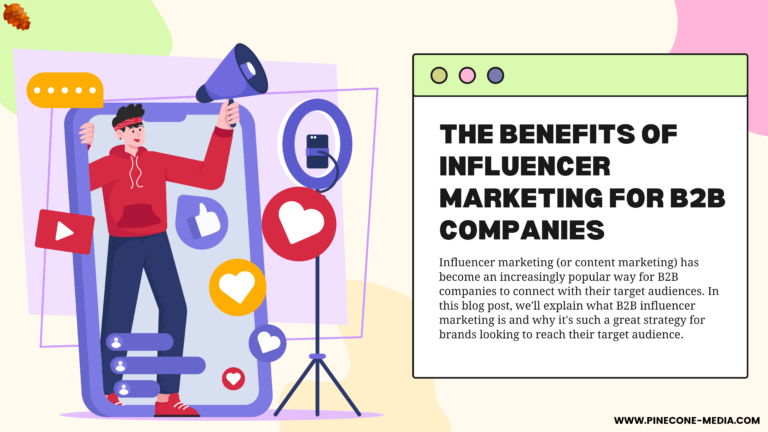Ten years ago, influencer marketing was primarily reserved for celebrities and a handful of committed bloggers. However, the landscape has dramatically evolved since then, with the emergence of social media influencers who have flooded the scene. Regardless of the size of their follower count, these influencers wield considerable influence. Their engaged and closely-knit communities foster genuine relationships, resulting in heightened trust and interaction.
Nevertheless, collaborating with digital content creators and influencers requires a nuanced approach for brands. In this guide, we provide valuable insights into comprehending this multifaceted realm. Explore our recommendations for crafting a compelling influencer marketing strategy, steering clear of common pitfalls, and much more.

What is influencer marketing?
Influencer marketing is a strategic approach to promoting products, services, or brands through individuals who have a significant and dedicated online following, often referred to as “influencers.” These influencers are typically experts, enthusiasts, or celebrities in a particular niche or industry and have established credibility and authority among their audience.
The core idea behind influencer marketing is to leverage the trust and engagement that influencers have built with their followers. Brands collaborate with influencers to create authentic and persuasive content that promotes their offerings. This content can take various forms, including social media posts, blog articles, videos, and more.
Influencer marketing aims to tap into the influencer’s existing audience, which is often a target demographic for the brand’s products or services. By doing so, brands can expand their reach, increase brand awareness, build trust, and ultimately drive conversions and sales.
It’s important to note that influencer marketing isn’t limited to celebrities with millions of followers. Micro-influencers, who have smaller but highly engaged audiences, can be just as effective or even more so in specific niches. Effective influencer marketing requires careful selection of influencers, a well-thought-out strategy, and an understanding of the target audience and goals.
Types of influencers:
- Celebrity Influencers: These are well-known individuals such as actors, musicians, athletes, and other public figures who have a massive following. They can reach a broad audience and bring high visibility to a brand.
- Macro-Influencers: Macro-influencers have substantial but not celebrity-level followings, typically ranging from tens of thousands to hundreds of thousands of followers. They often specialize in specific niches and can provide a balance between reach and engagement.
- Micro-Influencers: Micro-influencers have smaller, more niche-specific followings, typically in the range of a few thousand to tens of thousands of followers. They are known for their deep expertise and high engagement rates within their specific niche.
- Nano-Influencers: Nano-influencers have the smallest but highly engaged followings, often fewer than a thousand followers. They are considered everyday consumers who are passionate about a particular niche or product and can provide authentic and relatable endorsements.
Why use influencer marketing?
Influencer marketing offers several compelling reasons for businesses to incorporate it into their marketing strategies:
- Trust and Authenticity: Influencers often have dedicated and engaged followers who trust their recommendations. When an influencer endorses a product or service, it can feel more authentic and genuine than traditional advertising.
- Reach and Visibility: Influencers have the potential to reach a wide and diverse audience. They can help brands tap into new demographics and markets that might be challenging to reach through other means.
- Engagement and Interaction: Influencers engage actively with their followers, fostering two-way communication. This interaction can lead to increased brand engagement and valuable customer feedback.
- Content Creation: Influencers are skilled content creators. They can generate high-quality, relevant content that aligns with a brand’s image and message, saving brands time and resources.
- SEO and Online Presence: Collaborating with influencers can improve a brand’s online presence and search engine ranking. Quality backlinks from influencer partnerships can boost SEO efforts.
- Cost-Effective: Influencer marketing often provides a cost-effective way to reach a large and targeted audience, especially when compared to traditional advertising methods.
- Authentic Recommendations: Influencers have a personal connection with their audience, and their endorsements can carry more weight than generic advertising. These recommendations can lead to increased conversions and sales.
- Trackable Results: Many influencer marketing campaigns are highly trackable. Brands can measure the success of campaigns through metrics such as engagement rates, click-through rates, and conversions.
- Versatility: Influencer marketing can be adapted to various industries and niches. Brands can collaborate with influencers who align with their values and target audiences.
- Adaptation to Changing Trends: Influencers are often at the forefront of emerging trends and can help brands stay relevant in rapidly changing markets.
Overall, influencer marketing is a powerful tool for building brand awareness, trust, and engagement in a digital age where consumers are increasingly seeking authentic connections with the products and services they choose.
Influencer marketing mistakes to avoid
- Choosing the Wrong Influencers: One of the biggest mistakes in influencer marketing is selecting influencers solely based on their follower count. Instead, focus on influencers whose values and content align closely with your brand. Collaborating with influencers who don’t resonate with your target audience or whose values clash with your brand can lead to ineffective campaigns and potential backlash.
- Ignoring Authenticity: Authenticity is the cornerstone of influencer marketing. Encourage influencers to provide honest, unbiased reviews or endorsements. Trying to control the narrative too tightly or pushing influencers to promote products in a way that doesn’t feel genuine can damage trust with their followers and lead to campaign failure.
- Neglecting Disclosure and Transparency: Ethical and legal considerations are crucial in influencer marketing. Failing to ensure that influencers clearly disclose their partnerships with your brand can result in legal consequences and harm your reputation. Always provide influencers with guidelines on disclosure, and make sure they adhere to the relevant regulations in their region.
By avoiding these common pitfalls and focusing on building authentic relationships with the right influencers, you can maximize the effectiveness of your influencer marketing campaigns.
How to create an influencer marketing strategy in 5 steps
Creating an effective influencer marketing strategy involves several key steps. Here’s a simplified five-step guide:
- Set Clear Goals and Objectives:
Begin by defining your campaign’s specific goals and objectives. What do you want to achieve with influencer marketing? Is it brand awareness, increased sales, or engagement? Having clear goals will guide the rest of your strategy. - Identify Your Target Audience:
Understand your target audience’s demographics, interests, and behavior. This information will help you choose the right influencers who can effectively reach and engage your desired audience. - Find the Right Influencers:
Research and identify influencers who align with your brand and target audience. Consider factors like niche, follower demographics, engagement rates, and authenticity. Tools like influencer marketing platforms can assist in this process. - Plan Collaborations and Content:
Develop a collaboration plan that outlines how you’ll work with influencers. Decide on the type of content they’ll create (e.g., reviews, tutorials, sponsored posts), key messages, and the posting schedule. Ensure that content is aligned with your brand’s values and messaging. - Measure and Analyze Results:
- After the campaign is launched, track and measure its performance against your predefined goals. Monitor metrics such as engagement rates, website traffic, conversion rates, and social media growth. Analyze what worked well and what didn’t, and use these insights to refine future influencer campaigns.
Remember that influencer marketing is an ongoing strategy. Continuously assess your results and adapt your approach to improve effectiveness and achieve your brand’s objectives.
How to track influencer marketing campaigns
Tracking influencer marketing campaigns is crucial to measure their success and optimize your strategy. Start by establishing key performance indicators (KPIs) aligned with your campaign goals. Monitor engagement metrics such as likes, comments, shares, and click-through rates. Track referral traffic to your website from influencer posts using UTM parameters. Utilize unique discount codes or affiliate links to attribute sales directly to influencers. Social listening tools can help you gauge sentiment and audience feedback. Finally, gather feedback from influencers themselves to gain insights into their experience and audience interactions. Regularly analyze these metrics to assess your campaign’s performance and make data-driven adjustments for future collaborations.




